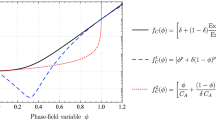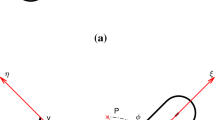Abstract
Structural topology optimization problems are commonly defined using continuous design variables combined with material interpolation schemes. One of the challenges for density based topology optimization observed in the review article (Sigmund and Maute Struct Multidiscip Optim 48(6):1031–1055 2013) is the slow convergence that is often encountered in practice, when an almost solid-and-void design is found. The purpose of this forum article is to present some preliminary observations on how designs evolves during the optimization process for different choices of optimization methods. Additionally, the authors want to open a discussion on how to properly define and identify the boundary translation that is often observed in practice. The authors hope that these preliminary observations can open for fruitful discussions and stimulate further investigations concerning slowly moving boundaries. Although the discussion is centered on density based methods it may be equally relevant to level-set and phase-field approaches.












Similar content being viewed by others
Notes
In this manuscript the word solve (in the context of optimization problems) should be understood as finding a point numerically satisfying the KKT conditions within some prescribed tolerances.
Number of optimization sub-problems solved.
The KKT condition of IPOPT cannot be obtained with the interface used in these numerical examples, and thus cannot be presented in Fig. 9.
References
Amestoy PR, Duff IS, L’Excellent JY (2000) Multifrontal parallel distributed symmetric and unsymmetric solvers. Comput Methods Appl Mech Eng 184(2–4):501–520
Andreassen E, Clausen A, Schevenels M, Lazarov BS, Sigmund O (2011) Efficient topology optimization in MATLAB using 88 lines of code. Struct Multidiscip Optim 43(1):1–16
Bendsøe MP (1989) Optimal shape design as a material distribution problem. Struct Optim 1(4):192–202
Bendsøe MP, Sigmund O (1999) Material interpolation schemes in topology optimization. Arch Appl Mech 69(9–10):635–654
Bendsøe MP, Sigmund O (2003) Topology optimization: theory, methods and applications. Springer-Verlag, Berlin Heidelberg
Boggs PT, Tolle JW (1995) Sequential quadratic programming. Acta Numerica 4:1–51
Bourdin B (2001) Filters in topology optimization. Int J Numer Methods Eng 50(9):2143–2158
Byrd RH, Hribar ME, Nocedal J (1999) An interior point algorithm for large-scale nonlinear programming. SIAM J Optim 9(4):877–900
Dennis JE, Moré JJ (1977) Quasi-Newton methods, motivation and theory. SIAM Rev 19(1):46–89
Forsgren A, Gill PE (1998) Primal-dual interior methods for nonconvex nonlinear programming. SIAM J Optim 8(4):1132–1152
Morales JL, Nocedal J, Wu Y (2010) A sequential quadratic programming algorithm with an additional equality constrained phase. J Numer Anal 32(2):553–579
Nocedal J (1980) Updating Quasi-Newton matrices with limited storage. Math Comput 35(151):773–782
Nocedal J, Wright SJ (1999) Numerical optimization. Springer-Verlag, Berlin Heidelberg
Nocedal J, Wächter R, Waltz RA (2009) Adaptive barrier update strategies for nonlinear interior methods. SIAM J Optim 19(4):1674–1693
Rojas-Labanda S, Stolpe M (2015) Benchmarking optimization solvers for structural topology optimization. Struct Multidiscip Optim 52(3):527–547
Rojas-Labanda S, Stolpe M (2016) An efficient second-order SQP method for structural topology optimization. Struct Multidiscip Optim 53(6):1315–1333
Rozvany GIN, Zhou M (1991) The COC algorithm, part I: cross-section optimization or sizing. Comput Methods Appl Mech Eng 89(1–3):281–308
Sigmund O (1997) On the design of compliant mechanisms using topology optimization. J Struct Mech 25(4):492–526
Sigmund O (2009) Manufacturing tolerant topology optimization. Acta Mech Sinica 25(2):227–239
Sigmund O, Maute K (2013) Topology optimization approaches. Struct Multidiscip Optim 48(6):1031–1055
Svanberg K (1987) The method of moving asymptotes - a new method for structural optimization. Int J Numer Methods Eng 24(2):359–373
Wächter A, Biegler LT (2006) On the implementation of an interior point filter line-search algorithm for large-scale nonlinear programming. Math Program 106(1):25–57
Yamashita H (1998) A globally convergent primal-dual interior point method for constrained optimization. Optim Methods Softw 10(2):2–4
Zhou M, Rozvany GIN (1991) The COC algorithm, Part II: topological, geometrical and generalized shape optimization. Comput Methods Appl Mech Eng 89(1–3):309–336
Acknowledgements
We would like to thank Professor Krister Svanberg at KTH in Stockholm for providing the implementation of MMA. We also express our sincere thanks to the two reviewers and the editor for their honest comments and suggestions which lead to improvements of the article.
Author information
Authors and Affiliations
Corresponding author
Additional information
This research is funded by the Villum Foundation through the research project Topology Optimization – the Next Generation (NextTop).
Rights and permissions
About this article
Cite this article
Rojas-Labanda, S., Sigmund, O. & Stolpe, M. A short numerical study on the optimization methods influence on topology optimization. Struct Multidisc Optim 56, 1603–1612 (2017). https://doi.org/10.1007/s00158-017-1813-2
Received:
Revised:
Accepted:
Published:
Issue Date:
DOI: https://doi.org/10.1007/s00158-017-1813-2




